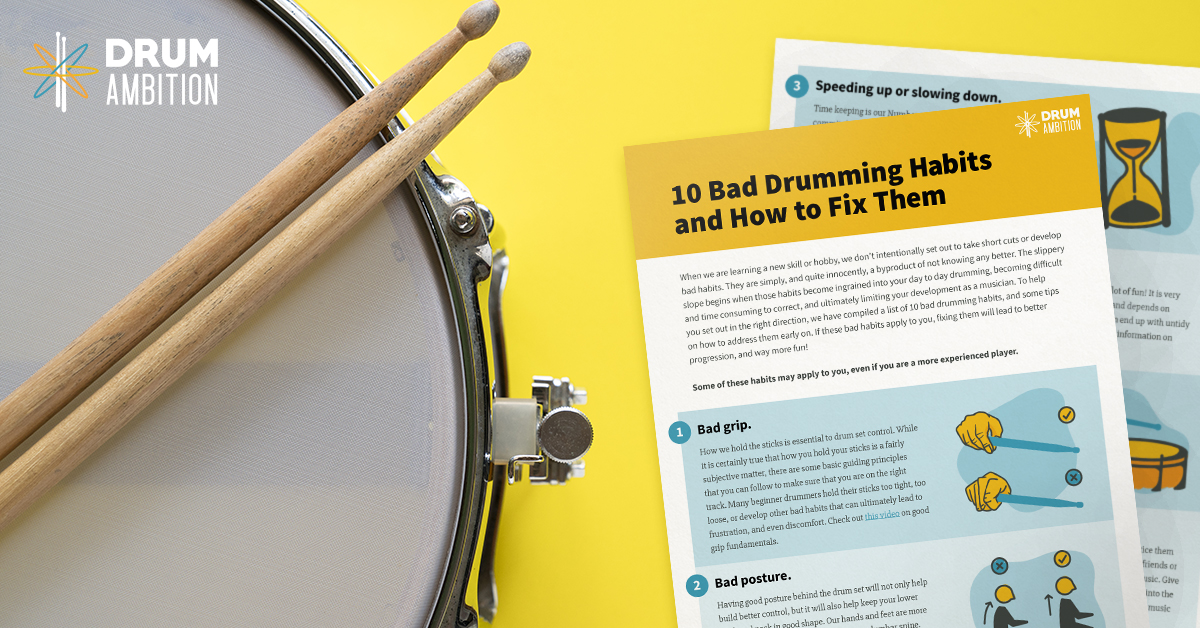Playing along with your favorite songs on the drums is a lot of fun, especially when approached in the right way. If you find yourself obsessing about playing a drum part exactly as it was recorded, or struggling because it's too technical or too fast, then this article will help you.
Simplification is a word that often comes up in our videos. You can apply the simplification approach to just about every aspect of your drumming, from beats and fills to playing along with songs to the actual drum setup that you choose. Simplification should not be seen as a shortcut. It can be used as a stepping stone to a specifically defined goal, or it can be a choice - an accepted and often necessary compromise. It is the key to having fun on the drums and satisfying the inner rockstar in all of us.
Helpful related articles.
10 bad drumming habits and how to fix them.
How do I drum faster? Why speed is a byproduct of control.
Small changes to the drumbeat can make a big difference.
Nothing takes the fun out of playing along to your favorite song than realizing that the part may be too technical to play. This is a prevalent scenario for most beginner drummers, as naturally, you are still honing your fundamentals. We recently helped a subscriber who wanted to play the track, Sweet Home Alabama. Just one-sixteenth note on the bass drum line (The "A" of the 2, for those of you who understand the reading and know the song) prevented her from playing the verse beautifully at the song tempo of 98bpm. By simplifying the part and removing the offending 16th note, we could develop a perfectly playable and musically acceptable part. No one is going to come up to you and say, "Nice job on the groove, but I think you might be missing the A of the 2 on the bass drum."
As long as the main backbeat is there, the finer nuances can always be worked out and added later. We also came up with a plan to play the actual beat, true to the original recording, starting at 55bpm. Over a few weeks, by increasing this starting point by 5bpm each time, she eventually reached the goal of 98bpm and could play the beat comfortably. Speed is always a byproduct of control, as this article emphasizes.
If you are struggling with a beat, take a moment and identify which parts are essential. Then think about what you could do without. At this point, you are on your way to simplifying the part and having a lot more fun and less frustration. Come up with a plan to work on the part as originally recorded, starting at slower tempos. Manage your expectations and commit practice time to this task.
Drum fills can also be modified.
We always encourage students to play their own variation of a drum fill. You might be playing a Foo Fighters song, but Taylor Hawkins is not in the hot seat - you are! Taylor Hawkins has been playing for decades, and this is a new experience for you, so it's important and necessary to manage your expectations. Again, if you formulate a plan to work on the fill that is challenging you, you will get to where you want to be over time. Start slowly, and think about the sticking.
In the meantime, adding your own fill is more fun and will mean you can play the song sooner. Perhaps the one exception to this approach is the iconic drum fill. For example, if you are playing In The Air Tonight by Phil Collins, there's a lot to be said for nailing that iconic drum fill. Yes, that one. Start slow, and build up speed over time, as we have discussed. 99% of songs, however, do not have iconic fills. They may be tasteful, musical, or technically proficient - but when all is said and done, they are mostly just fills.
Building speed through control.
Most drum students, and many experienced drummers for that matter, can struggle to keep up with songs that may have higher tempos. The issue is not exclusively the song's speed but the technique required to play musically, efficiently, and comfortably at higher speeds. As a beginner drummer, you are still honing these skills, and this article can help you understand how to approach the challenge of speed. One common solution is to simplify the beat. If the beat is too fast in 8th notes, try playing it in 1/4 notes. If the beat is too fast in 16th notes, try playing it in 8th notes. It would help if you had a basic understanding of music notation to comprehend this, and our music notation videos explain everything in methodical and easy-to-understand steps. While you are having fun playing your simplified beat, you should have a plan in your practice routine to work on the beat as played on the recording, at slower tempos, working with a metronome, and increasing in small increments as you make progress.
Learning the drums should be fun, and playing along to music is a milestone for beginner drummers. If you are finding working on a song frustrating, try simplifying. If you are not a Drum Ambition subscriber, check out our curriculum. We specialize in simplifying the experience without taking shortcuts and fine-tuning the important fundamentals.
We are here to help.
If you have any questions about this article, please feel free to email [email protected].



